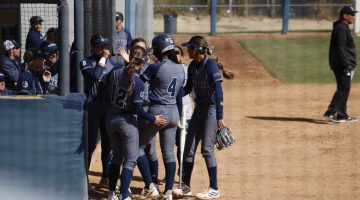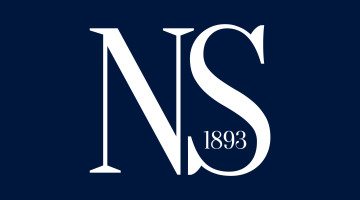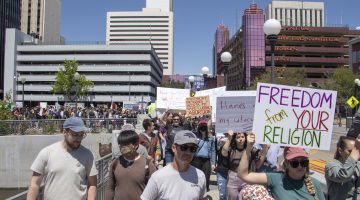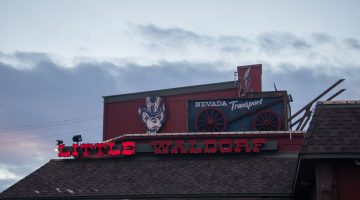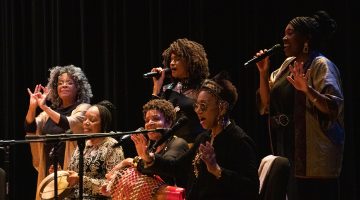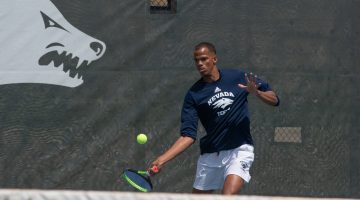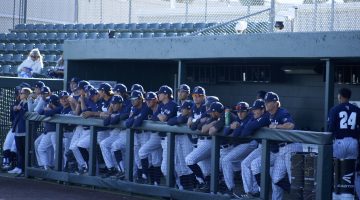
Breanna Denney/Nevada Sagebrush Argenta Hall houses students on Monday, Sept. 14. Argenta’s rooms accommodate three students – a number that is becoming more common in residence halls across campus.

Marcus Lavergne/Nevada Sagebrush
Students walk to class in front of the Mathewson-IGT Knowledge Center on Friday, Aug. 28. The 2015 fall semester has brought the largest student population the University of Nevada, Reno, has ever seen.
By Marcus Lavergne
While students, packed tightly like sardines in a can make their way through areas like the University of Nevada, Reno’s Joe Crowley Student Union food court, classrooms and lecture halls have managed to accommodate the largest student population the campus has ever seen. The news that students’ academic needs are being met despite the increase over the past few semesters has been a relief for UNR’s administration.
Data provided by the 2014 UNR Capacity Study implies that significant changes are in store. Renovations, remodeling and repurposing seem to be a major theme for coming semesters. There is one word that truly encompasses UNR’s situation — growth.
In the past two years, staff in the Office of the President have authorized 101 new faculty positions and 71 graduate assistant positions at the University of Nevada, Reno. Thompson Hall, White Pine Hall and Manzanita Hall are all up for potential repurposing, which could create more faculty work space on campus. Within five to six years, enrollment is expected to reach 22,000.
Serge Herzog is the director for the Office of Institutional Analysis. This branch of Planning, Budget and Analysis produces reports and studies on operations on campus. Herzog points out that the growth expresses a need for more faculty, more office space and more faculty research labs, rather than student work space.
“The capacity report highlights the areas where UNR needs to expand its infrastructure,” Herzog said. “We actually have enough [instructional space] to accommodate another 7,000 students.”
Although Herzog knows that many needs must be accommodated, he remains optimistic about the upswing on campus.
“Bigger universities tend to have a certain quality that is harder to get with smaller universities,” Herzog said. “That’s simply because as the university gets bigger it increases its resources, which in turn are to the benefit of the students.”
Herzog pointed out that UNR’s national reach is also becoming bigger. He says that the university’s growth is not due to an influx of graduating northern Nevada seniors but rather newly enrolled students from places in different regions.
“We have admitted more students from Clark County than we have from the local Reno-Carson area,” Herzog said. “The students coming from out-of-state, particularly from California, their numbers are pretty much approaching the numbers that we get locally.”
Herzog believes that UNR is becoming more of a regional university and that it’s a good thing. The more national recognition the university achieves, the more attractive it becomes for students. Herzog calls it the “peer effect.”
The university’s growth has forced those working in the Office of the President to plan accordingly in order to accommodate both faculty and students on campus. By doing capacity studies like the one conducted in 2014, the Office of the President and President Marc Johnson have potentially prepared themselves for more campus development. The study says that “as of now the current capacity certainly exists to absorb the anticipated growth in student enrollment.” This means that plans had to be set in motion before now in order to counter and control the rising population numbers.
Also, faculty size is increasing, and building creation and repurposing can be seen across campus. As reported in the capacity study, the student-to-faculty ratio on campus is around 22:1. President Johnson has high hopes of reducing this number to 18:1, the national median for other land-grant universities. He is working alongside people like Bruce Shively, the Associate Vice President of Budget, Planning and Analysis at UNR.
Shively admits that last year, when enrollment grew over 6 percent, it took the staff by surprise. He says that the Office of the President was much more prepared for the smaller, but still significant, increase this year.
“[Growth] was larger than expected by quite a bit,” Shively said. “Since that time, we’ve tracked our enrollment much closer and have developed some computing capabilities that allows [us] to assess the need for additional sections, so I think we were in much better shape this year to accommodate the growth.”
Shively also says that in terms of the key hours that students attend classes, classrooms are full. He says that it’s actually a good thing because it allows the university to make use of its resources throughout the day. Although students are getting into classes and receiving instruction, there is still an increasing need for faculty and faculty work space.
Shively believes that the need for new faculty could reach numbers of around 400 in the next five to six years. That number is large, and Shively made clear that meeting the need for more staff is imperative to accommodating students’ learning needs.
“Now the growth is larger than we expected,” Shively said. “But we’re mindful of the experience that students have. While we have big goals, the important goal is that students have classes and can graduate in four years.”
Though population size has been increasing at a much faster rate than anticipated, Shively thinks the Office of the President staff has planned well enough to handle the steadily increasing student body.
“What we’re trying to do is manage this growth,” Shively said. “If you chat with the deans I think they’re beginning to see that ‘Yeah, hey, we’re following through with what we said we were going to do and we’re actually doing what we can to maintain that student experience.’”
Shively ultimately sees the growth as an exciting and controllable phase of the university’s development. He claims that through the rising numbers there is positive metric growth.
“The quality of the students coming in has substantially improved,” Shively said. “There’s been a heck of a lot of good here.”
Shively does want students to know that uncontrollable growth is not something the university is interested in. With preparations in place, he hopes that growth will continue at a level that the staff can manage.
Marcus Lavergne can be reached at mlavergne@sagebrush.unr.edu and on Twitter @mlavergne21.


